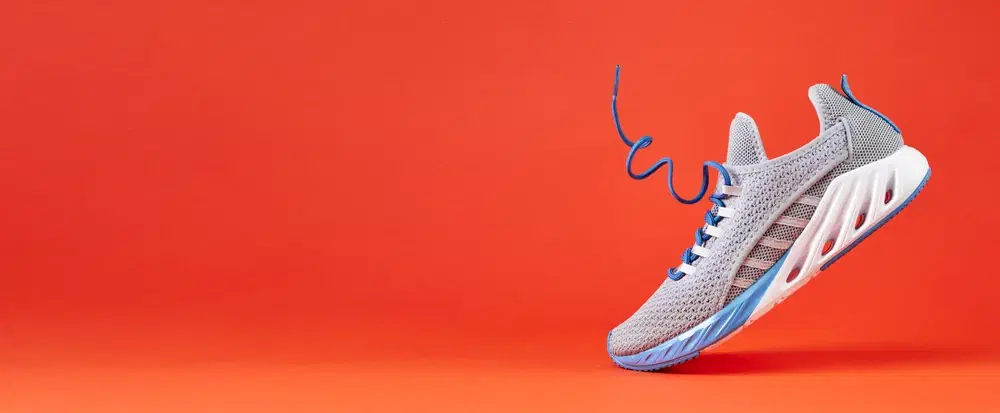
Footwear Guide
•05 min read

Flat feet, also known as fallen arches, can bring unique challenges during your runs. This guide is here to help you choose the best running shoes for flat feet. It explains the key features to look for, how the right footwear can boost comfort and stability, and offers expert insights to ensure you make an informed decision for your running needs.
Flat feet occur when the natural arch of the foot is low or collapses. This condition means the entire sole touches the ground, which can lead to overpronation—the foot rolling inward too much during each step. Overpronation is commonly observed among runners and increases stress on your muscles and joints, often resulting in discomfort during and after your run.
For runners with flat feet, extra support is essential. The lack of a natural arch can lead to instability and uneven pressure distribution while running. This imbalance may cause:
- Increased pressure on joints and muscles
- Reduced shock absorption during impact
- A higher risk of chronic pain or injuries like plantar fasciitis
Choosing supportive running shoes for flat feet can help address these challenges. Shoes with arch support, stability features, and cushioning are particularly beneficial. They help control overpronation, evenly distribute pressure, and absorb impact, ensuring that your run is both comfortable and safe.
Arch support is crucial for reducing the extra strain on flat arches. Look for footwear that is described as arch support shoes for runners or stability shoes for flat feet. These shoes help maintain proper alignment and lessen the load on your foot during each stride.
Motion control running shoes help prevent excessive inward rolling by providing firm support. These shoes are designed to offer structured support to flat feet, making them ideal for runners who experience significant overpronation. This technology is especially useful for flat feet athletic footwear.
Cushioned running shoes for flat arches provide essential padding that absorbs shock and softens the impact on every run. With soft midsoles and responsive cushioning, these shoes ensure a smooth and comfortable experience whether you are on a long run or recovering from a hard workout. For added search relevance, consider comfortable running shoes for flat feet or best sneakers for flat feet.
A wide toe box is a must-have in running shoes if you have flat feet. It allows enough space for your foot and prevents pinching and irritation. Additionally, flexible materials move with your foot, adapting to your unique contours during every run.

Stability running shoes offer a balance between cushioning and support, which is perfect for flat-footed runners experiencing mild overpronation. They typically include reinforced midsoles or medial posts that help maintain proper foot alignment while running.
For runners who struggle with severe overpronation, motion control running shoes provide the extra support needed. Their design often features firmer midsoles and rigid heel counters. This design works to stabilize the foot and guide it through a more controlled movement, reducing fatigue and potential injuries.
If comfort is your priority, consider cushioned running shoes for flat feet. These shoes focus on providing maximum shock absorption and softness. Ideal for long-distance runs or recovery days, they help protect your joints and reduce stress on your feet.
Before selecting any footwear, it’s important to understand whether your flat feet are natural or a result of collapsed arches. Simple tests like the wet footprint test or a consultation with a specialist can help you know your foot type better. This understanding will guide you in choosing shoes that equally emphasize support and comfort.
Your running style influences the type of support you need. Whether you are a casual jogger, a marathon runner, or someone recovering from an injury, make sure your shoes match your style. This ensures that the shoes provide adequate grip, cushioning, and stability based on the intensity and duration of your runs.
Always take the time to try on shoes before finalizing your choice. A proper fit involves a snug heel grip to prevent slipping and ample room in the toe box for natural movement. Remember how a well-chosen pair can boost not only performance but also confidence. Test out shoes that offer supportive and comfortable features, such as cushioned running shoes for flat arches or motion control running shoes if you experience severe overpronation.
While a trendy look is appealing, the primary focus should be on functionality. The right pair of shoes can significantly enhance your running performance and comfort by keeping your feet stable and protected from injuries. These shoes not only enhance your performance but also let you showcase your unique athletic style, blending functionality with vibrant design.
Insight Corner: "Flat Feet Don’t Mean Flat Performance"
Did you know that many enthusiastic runners with flat arches have achieved great performance milestones? With supportive running shoes for flat feet—especially those offering arch support and motion control—flat-footed runners can overcome discomfort and push their limits.

Neglecting proper arch support is a common mistake that can lead to severe discomfort and long-term foot issues. Always choose shoes that deliver robust support for your arches. Running shoes for flat arches are specifically engineered to distribute pressure evenly and reduce the risk of injury.
Selecting a neutral shoe that lacks stability features can be detrimental. Shoes designed for flat-footed runners must address overpronation effectively. Therefore, avoid options that do not offer adequate corrective features when looking for supportive running shoes for flat feet.
An improper fit can lead to a host of issues like blisters, discomfort in the toe box, and instability during runs. Testing for a correct size is essential before settling on your footwear. Only opt for running shoes that feel secure yet comfortable from the very first step.
Supportive and cushioned running shoes for flat feet are great for women, offering a balance between stability and comfort. Look for models that emphasize arch support and motion control.
Yes, many options hustle to provide stabilized motion and cushioning. Shoes for flat-footed runners that cater to men typically focus on a secure fit and enhanced support features.
Indeed, flat feet can heighten the risk of plantar fasciitis because of the added strain on the plantar fascia. Proper shoes help reduce this risk through adequate support and cushioning.
Stability shoes offer moderate support for mild overpronation, while motion control shoes provide maximum correction for severe inward rolling of the foot.
Absolutely. Cushioned running shoes for flat arches deliver extra comfort and shock absorption, making them particularly appealing for long runs or recovery sessions.
Choosing the best running shoes for flat feet is all about understanding your foot type and aligning your running style with the right features. Prioritize shoes that bring stability through motion control, comfort through cushioning, and a proper fit to safeguard against injuries. This focused approach ensures a smoother, more enjoyable running experience. With a well-thought-out selection process, flat-footed runners can easily embrace their passion for running, knowing their footwear supports both style and performance. Explore our footwear guide to learn more about the features that make running a safe and enjoyable pursuit.